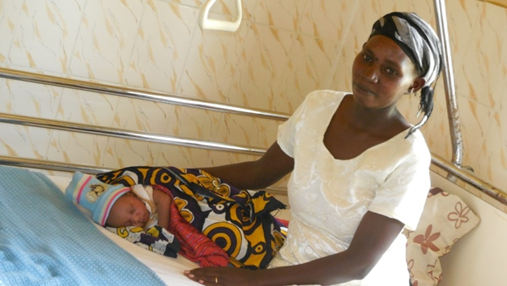
June 2014—Alice Mtune is 32 years old and a mother to six children. The youngest was born in September 2013 at the Msulwa Dispensary in Kwale County, about 58 kilometers from the coastal town of Mombasa, Kenya. She is pleased with the care she received at the dispensary.
“This place is nice because I was able to deliver my baby safely even though he was in the breech position. I also took a warm bath after giving birth and this re-energized me such that, on the day I was discharged, I preferred to walk home as opposed to taking a motorcycle which was readily available,” said Mtune.
Mtune started her antenatal care appointments when she was five months pregnant at the advice of her "birth champion,” Lydia Kafula. In Kenya, traditional birth attendants are untrained midwives who help women deliver at home, while "birth champions" are attendants who undergo specialized training and accompany pregnant women to health facilities. Kafula checked on Mtune regularly and helped her prepare a personal birth plan, where she chose to deliver in a hospital.
For her first four children, Mtune's first antenatal clinic appointment took place when she was eight months pregnant, and she delivered at home with Kafula by her side. Because the children all survived home births, Mtune was hesitant when Kafula explained the importance of going to antenatal visits and delivering in a hospital. Kafula advised Mtune and her husband about the possible dangers of home delivery and the benefits of delivering in a hospital.
Msulwa Dispensary, where Mtune delivered her fifth and sixth babies, is one of 21 health facilities that participated in the Kwale improvement collaborative supported by USAID. The collaborative began in 2011 as part of the USAID Health Care Improvement project. Each facility created an improvement team responsible for identifying problems within the facility and formulating possible solutions that are tested over time to determine effectiveness. Potential solutions that work well are adopted while those that do not are either modified or discarded.
With help from trained health care workers, these improvement teams, comprised of community members, monitor services and solutions. Key to the fight against maternal mortality are the team members who include clinically skilled health care workers; community health workers, who are chosen by community members or organizations to provide basic health and medical care; chiefs and spiritual leaders.
The improvement teams learned how to identify problems and develop local solutions. The transformation of traditional birth attendants into birth champions was one of the solutions used to address maternal mortality. Another was sharing the telephone numbers of midwives with expectant mothers. If the women went into labor at night, they called the midwives, who would accompany them to the health facility. This ensured expectant mothers access to services 24 hours a day as opposed to the previous eight hours of availability.
The solutions introduced by improvement teams, coupled with the waiver of maternity fees in all public hospitals in June 2013, helped reduce the maternal mortality rate from 700 per 100,000 live births to 590 in January 2011, and to 346 in September 2013.
USAID's Health Care Improvement project, implemented by University Research Co. LLC, helps countries worldwide to improve the quality and impact of health services in child health, maternal and newborn care, HIV/AIDS, tuberculosis, malaria and reproductive health. In Kenya, the project ran from 2009 to 2012, and was succeeded by the Applying Science to Strengthen and Improve Systems Project.
Links
Follow @USAIDKenya, on Facebook, on Flickr, on YouTube







Comment
Make a general inquiry or suggest an improvement.